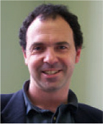ICONN 2006 Research Highlights
Paul Mulvaney AA School of Chemistry, University of Melbourne, Parkville, VIC 3010, Australia.

Paul Mulvaney is currently an ARC Federation Fellow and Professor of Chemistry in the School of Chemistry and Bio21 Institute at the University of Melbourne. He received his Ph.D. from the University of Melbourne in 1989 for studies on the radiation-induced dissolution of colloidal metal oxides. He carried out postdoctoral research work at the Hahn–Meitner Institute in Berlin from 1989 to 1992. He was a Humboldt Research Fellow at the Max–Planck Institute for Colloids and Surfaces in Potsdam in 2000, and again at the CAESAR Institute in Bonn in 2005. His current interests involve the optical properties of single quantum dots, surface plasmon spectroscopy of single metal nanocrystals, nanocrystal-based biochemical markers, nanocrystal-based electronics, photonic crystals, nanomechanics, and the use of atomic force microscopy to measure surface forces. |
Australian Journal of Chemistry 60(7) 445-446 https://doi.org/10.1071/CH07094
Submitted: 4 April 2007 Accepted: 4 April 2007 Published: 9 July 2007
The first Australian national nanoscience and nanotechnology conference, ICONN 2006, was held at the Convention Centre, Brisbane, in July 2006. Sponsored by the ARC Nanotechnology Network, it marked the first attempt to create a multidisciplinary conference that not only focussed on some of the exciting science in the ‘nanofields’ but offered free registration to all postgraduate students and early career researchers. This was recognition that not only is nanoscience and technology a young field, but there is an urgent need in physical and chemical sciences to ensure the uptake of the science and to convey the enthusiasm to the community. The future of nanotechnology is in the hands of the industries that must take it up and in the minds of the young researchers currently wrestling with the novel materials, the quantum phenomena, and the multidisicplinary nature of the research. The conference also involved extensive discussions on the health and environmental, legal, patenting, and ethical issues that nanotechnology may raise for the community.
The papers published in this Research Front represent some of the highlights of the Nanomaterials Symposium at ICONN 2006. We are delighted that Australian Journal of Chemistry—an International Journal for Chemical Science is making this Symposium the focus for one of its Research Fronts. Metal particles, semiconductor nanocrystals, and carbon nanotubes were definitely the more popular topics, and these papers represent a good cross section of the topics covered both as oral presentations and at the poster sessions that included over 200 contributions. Particularly exciting for ICONN 2006 was the high participation rate from overseas registrants and speakers. This bodes well for ICONN 2008 in Melbourne.
The first paper[1] by Gero von Plessen and colleagues covers the exciting area of plasmonics, which is starting to impact heavily in sub-wavelength optics. The authors cover some of the important ideas underlying colour changes in nanoscale metal particles and also some of the likely areas where plasmonics may play a role in the next few years.
Joel van Embden[2] then reviews the processes involved in passivating semiconductor nanocrystals. Luminescence from these crystals is tunable across the visible spectrum, but it is very sensitive to surface processes and easily quenched. Epitaxial deposition of a shell may offer the best hope for these materials in applications.
Liming Dai was a leading scientist in carbon nanotube (CNT) research at CSIRO in Australia before moving to Daytona in Florida. Here he reviews recent work on quantum size effects in CNTs and their applications to sensor technologies.[3]
At Swinburne University, Professor Min Gu is Australia’s foremost expert on high density information storage, a vital platform for both data storage and for display technologies. The new technique of two-photon polymerization offers the chance to go below conventional diffraction limits and expand densities by an order of magnitude. Multi-layer storage is also an emerging possibility using two-photon techniques. Min Gu reviews the potential of these new concepts and explains where they may lead in the coming decade.[4]
The final Review[5] is by Yiu-Wing Mai who demonstrates that clay may become the material of the future. Clays now offer various hierarchies in structure, shape, crystallinity, and reactivity. Tuning clay properties and the doping of conventional materials with clays is now becoming a high-tech field.
In addition to these review articles, several new breakthrough papers are also presented in this issue. Max Lu and colleagues at the ARC Centre for Functional Nanomaterials at the University of Queensland report on improving the hydrogen uptake in CNTs using chemical treatment to modify the surface groups on the nanotubes.[6] Enhanced photocatalytic properties of vanadium/titanium mixed metal oxide sol-gel based materials[7] is reported by Rachel Caruso et al. from the University of Melbourne. A paper[8] from the Nanoscience Centre at the University of Technology, Sydney, led by Professor Mike Cortie, describes new gold microsponges with very high surface area prepared by a novel leaching process. Finally, new CNT architectures and membranes based on carbon nanotubes are discussed by Haddon and colleagues,[9] and the scale up of nanotube production by fluidized bed techniques, a process vital for commercializing CNTs, is explored by See and Harris.[10]
These papers offer a glimpse into the many ways nanoscience and nanotechnology are likely to impact our lives in the next few decades. We thank the Australian Journal of Chemistry for supporting the nanomaterials symposium through this special Research Front, and hope that ICONN 2008 will be as exciting a meeting for chemists and materials scientists.
[1]
C. Dahmen,
G. von Plessen,
Aust. J. Chem. 2007, 60, 447.
| Crossref | GoogleScholarGoogle Scholar |
| Crossref | GoogleScholarGoogle Scholar |
| Crossref | GoogleScholarGoogle Scholar |
| Crossref | GoogleScholarGoogle Scholar |
| Crossref | GoogleScholarGoogle Scholar |
| Crossref | GoogleScholarGoogle Scholar |
| Crossref | GoogleScholarGoogle Scholar |
| Crossref | GoogleScholarGoogle Scholar |
| Crossref | GoogleScholarGoogle Scholar |
| Crossref | GoogleScholarGoogle Scholar |



